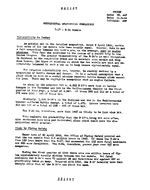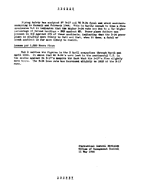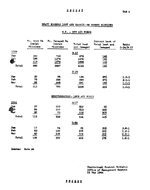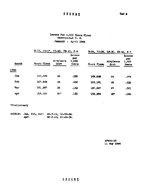Nightengale
Recruit
- 1
- Dec 28, 2022
The B24 had a substantially lower ceiling than the B17. Why? Was it the Davis wing? The different engines?
Follow along with the video below to see how to install our site as a web app on your home screen.
Note: This feature may not be available in some browsers.
Ad: This forum contains affiliate links to products on Amazon and eBay. More information in Terms and rules
So did the B-24 formations.I'm gonna' catch some flak for that.
| HB sorties | Airborne | SortieL | credit | effective | MIA |
| Bombing | 330866 | 318793 | 293919 | 266872 | 4139 |
| Carpetbag | 2844 | 2844 | 2750 | 1847 | 24 |
| Trucking | 2434 | 2434 | n/a | 2323 | 2 |
| Leaflet | 2428 | 2428 | 2302 | 2298 | 3 |
| RCM | 1159 | 1152 | n/a | 1110 | 2 |
| Special | 202 | 202 | 180 | 173 | |
| ASR | 16 | 16 | n/a | 16 | |
| Scout | 207 | 207 | n/a | 197 | |
| Aphrodite | 35 | 35 | 35 | 35 | |
| Weather | 1553 | 1553 | 1493 | 1485 | 2 |
| Total | 341744 | 329664 | 300679 | 276356 | 4172 |
| MIA | Cat E | Missing unknown | Type |
3093 | 1025 | 126 | B-17 |
1099 | 551 | 36 | B-24 |
I'm gonna' catch some flak for that.
I mainly agree with the critic of the article. The statistical approach. 8th Air Force for war, heavy bombers.
343 airborne bomber sorties were at night, 745 tons of bombs. SortieL are airborne less diversions, recalls, unused spares etc. Special is 482 BG missions testing H2X etc. Bombing sorties are those by the bomber units, unless explicitly reported otherwise excluding leaflets, special units and trucking operations, but do include 1,404.9 tons of supplies dropped by parachute June to August 1944, 598 tons dropped in March 1945 (costing around 18 B-24 and most of their crews out of 240 on the low level operation), total such supply sorties unknown, plus the 2,276 / 2,275 / 78 / 2,254 / 1 sorties in May 1945 dropping 4,184.1 tons of supplies in the Netherlands. Over and above the dedicated leaflets unit, the bombers dropped 2,086.6 tons of leaflets.
HB sorties Airborne SortieL credit effective MIA Bombing Carpetbag Trucking n/a Leaflet RCM n/a Special ASR n/a Scout n/a Aphrodite Weather Total
Trucking operations were done August 1944 to April 1945, total 9,880.2 tons or which 9,623.8 tons were in September 1944. They are not counted as bomber sorties.
Figures also exclude the three deployments to North Africa, 1,453 sorties, 1,288 effective, 3,365 tons of bombs, 69 aircraft MIA. (Including 30 in the Ploesti raid)
Losses for war
Missing unknown is aircraft believed to have landed in friendly territory on the continent, unlocated and/or unheard of during the month of loss or 30 days thereafter. The B-17/24 attrition table says 5,930 MIA/Cat E/Missing the Aircraft Loss Rate table says 5,857. Implying about half the missing were total losses. Note 4,172 MIA in the sortie table and 4,192 in the attrition table.
MIA Cat E Missing unknown Type B-17 B-24
The December 1944 report says in 1944: B-17 1,879 MIA, 506 Category E, 83 missing unknown, B-24 842, 363 and 18. B-17 250 tons of supplies by parachute in September 1944, B-24 510 tons Losses on ground considered non operational.
Statistical summary of 8th Air Force Operations says in 1944: B-17 1,881 MIA, 503 Category E, 78 missing unknown, B-24 883, 348 and 17. While the official figures tend to agree on sortie totals losses have their differences.
Using credit sorties and ignoring the missing unknown the 1944 report says B-17 MIA rate 1.54%, overall loss rate 1.96%, B-24 1.33% and 1.86%. Using the summary B-17 MIA rate 1.54%, overall loss rate 1.96%, B-24 1.27% and 1.82%. A third set of figures B-17 1,957 MIA, 502 Cat E, 1.61%, 2.02%, B-24 858 MIA, 346 Cat E, 1.30% and 1.82%. Overall the B-24 has a lower loss rate but more chance of being written off in crash landings.
For 1944/45 the B-17 operational accident rate per 100 take offs was 0.22, non operational accidents per 1,000 hours were 0.97, the B-24 0.3 and 1.01. Result total accidents were 931 B-17 and 558 B-24. When it came to fatal accidents 150 B-17 with 1,092 deaths, 148 B-24 with 1,049 deaths.
For the 8th Air Force for the war B-17s were 68.5% of the heavy bombers sent on missions, 69.2% of credit and 70.2% of effective sorties. B-17 were 62% of mechanical, 58.7% of weather and 61.5% of other cause aborts. B-17 MIA rate of 1.6% of credit sorties and a total loss rate of 2.1% of credit sorties dropping an average of 5,140 pounds of bombs. B-24 MIA rate was 1.2%, total loss rate 1.8% average bomb load of 5,321 pounds.
From a near complete list of B-17 losses but missing some B-24 ones.
Deaths when shot down by fighters, for the B-17 about 37% of an average 9.74 man crew were KIA when lost to fighters, 32.1% of an average 9.2 man crew were KIA when lost to flak. For the B-24, after taking out the low level mission flak losses, something like 49.4% of an average 9.4 man crew were KIA when lost to fighters. 37.1% of an average 8.9 man crew when lost to flak.
The Luftwaffe kill claims against 8th and 15th AF B-17s are remarkably consistent, over claiming by about 2 to 1 month after month for the entire campaign. Assuming all the B-17s listed as lost to battle damage, unknown causes or a combination of flak and fighters were in fact lost to fighter attack means the monthly figures move around a lot more and the over claim ratio for the entire campaign drops from 2.1 to 1.7 to 1. The figures for the 8th AF B-24 losses indicate Luftwaffe over claims were under 2 to 1, if all the unknown etc. losses were to fighters it would be as low as 1.5 to 1, and the upper bound around 1.95 to 1. This seems to indicate the B-24 was easier for a fighter to shoot down.
What a lot of people don;t think about when it comes to statistics is that the MIA rate and overall loss rates depend largely on what targets the aircraft were assigned to hit. Now, we can't perform the experiment, but what do you think the rates would be if we exchanged B-17s with B-24s and each hit the other's targets?
With a large enough sample size, variations due to target difficulty should average out.
I thought my note about agreeing with the critic was enough to avoid needing to point out the limits of statistics.
Loss rates go up with distance and bad weather before the bad guys do anything and the longer the distance the less reliable the weather forecast is. Rates go up with time spent in hostile airspace. It is easy enough to count the AA guns around targets to compute that risk but the real killers of bombers are fighters and that means working out the chances of interception, starting with how many fighters are in range of the route and how good the interception control is.
Against the bad weather loss bias idea is the RAF seems to have preferred cloudy days when bombing the Ruhr by day, using the more accurate ground based bombing aids in exchange for decreased flak accuracy, the Luftwaffe's decision to discontinue instrument training for day fighters also made bad weather safer for the allies.
The statistics do tell us what happened, the actual performance of the aircraft in the real life situation, and it does point why some decisions were made, like converting the mixed bomb division to all B-17 instead of all B-24. Also the way it happened, the altitudes, speeds, bomb loads etc. The statistics show the B-24 had a higher ratio of Category E to MIA on operations buy that is at least partly due to the B-24 taking more damage on average in a crash.
As for hairy mission, statistics work best for large numbers of missions where all the different factors tend to head towards their average. Missions with above average losses are the hairy ones. As an aside WWI had things like Bloody April but looking at the loss statistics as a percentage of sorties flown, those losses would be well within the acceptable range in WWII.
However, because we disagree doesn't mean we have an issue between us; we don't. I just think the real killer was flak and loss rates weren't rising just because we were flying over Axis airspace.Have to disagree with your premise about losses and the "real killer of bombers."
If you look at the US Navy, let's take just the Hellcat.There were one-third more losses to AAA than to enemy fighters and about the same losses to enemy fighters as operational losses. The biggest single hit was AAA.
Look at the Statistical Digest of World War Two, Table 159: Airplane Losses on Combat Missions in the ETO (since we are in the ETO).
Enemy aircraft and AAA had almost the same number of losses (2,452 for enemy aircraft and 2,439 for AAA) for heavy bombers; 131 for enemy aircraft and 4,92 for AAA for medium bombers (who operated inside the flak envelope almost exclusively); and 1,691 to enemy aircraft and 2,449 to AAA for fighters (with 1,184 to operational losses).
From the above, flak was the best killer of airplanes and was equal to fighters as a bomber killer for heavy bombers and the best at it for everything else.
I flat disagree with "loss rates go up with time spent in hostile airspace." This was WWII, not modern warfare. The loss rates went up if they got attacked, sure, but time spent in hostile airspace didn't mean you would get attacked. If depended largely on here you were and what you were doing. If you were in a Mosquito on a PR run at altitude 30,000+ feet) and at speed (300+ mph), you were likely not going to get attacked. If you were in an A-20 at 15,000 feet by yourself and not headed for a well-defended target, you were unlikely to be attacked unless someone chanced across you. But, if you were in a large bombers stream headed for a well-defended target, you were very unlikely NOT to be attacked.
I disagree with "loss rates went up with distance" and "loss rates went up with weather." I have spent about 20 years around WWII warbirds. Their engines are reliable to the point of being almost laughably reliable. I worked the Planes of Fame Airshow for 10+ years. We ran 50+ sorties a day for 3 days once a year. That's 1,500+ sorties. We had a grand total of 5 aborts during those 10+ years. One was a Corsair who couldn't get one wing to unfold (hydraulic issue) and one was a flat tire. The other 3 were engine-related before takeoff. That's a total of 0.2% or less engine-related issues. Note, once running, we had one precautionary landing due to engine. That's 0.067% airborne engine issues. We also had one Curtiss-Electric prop get stuck in cruise pitch due to a failed electric brush setup. It was easily fixed once the parts were located. And that's for 70-year old engines. Imagine how much better they were when they were relatively new engines.
Weather is a factor only when it is extreme. Flying in clouds won't make you crash unless you have a midair, which is unlikely in formation but more likely in combat. Flying in a thunderstorm might well get you killed, but there is almost no excuse for flying into a thunderstorm. Only idiots do that and they generally don't survive to continue being idiots.
Not too sure that is correct if the B-17s (for example) hit Schweinfurt all the time and the B-24s (for example) hit much less well-defended targets all the time. I'm NOT saying B-24s hit less well-defended targets all the time ... I'm saying their target packages were not randomly spread around among the heavies.
Look at the Statistical Digest of World War Two, Table 159: Airplane Losses on Combat Missions in the ETO (since we are in the ETO).
Enemy aircraft and AAA had almost the same number of losses (2,452 for enemy aircraft and 2,439 for AAA) for heavy bombers; 131 for enemy aircraft and 4,92 for AAA for medium bombers (who operated inside the flak envelope almost exclusively); and 1,691 to enemy aircraft and 2,449 to AAA for fighters (with 1,184 to operational losses).
From the above, flak was the best killer of airplanes and was equal to fighters as a bomber killer for heavy bombers and the best at it for everything else.
I disagree with "loss rates went up with distance" and "loss rates went up with weather." I have spent about 20 years around WWII warbirds. Their engines are reliable to the point of being almost laughably reliable. I worked the Planes of Fame Airshow for 10+ years. We ran 50+ sorties a day for 3 days once a year. That's 1,500+ sorties. We had a grand total of 5 aborts during those 10+ years. One was a Corsair who couldn't get one wing to unfold (hydraulic issue) and one was a flat tire.




